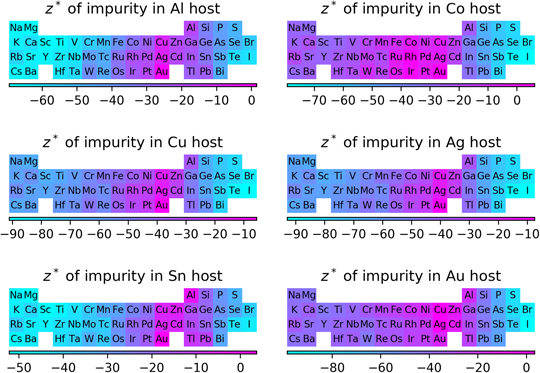Crossref Citations
This article has been cited by the following publications. This list is generated based on data provided by
Crossref.
Liu, Yu-chen
Yu, Yung-si
Lin, Shih-kang
and
Chiu, Shang-Jui
2019.
Electromigration effect upon single- and two-phase Ag-Cu alloy strips: An in situ study.
Scripta Materialia,
Vol. 173,
Issue. ,
p.
134.
Jacobs, Ryan
Mayeshiba, Tam
Afflerbach, Ben
Miles, Luke
Williams, Max
Turner, Matthew
Finkel, Raphael
and
Morgan, Dane
2020.
The Materials Simulation Toolkit for Machine learning (MAST-ML): An automated open source toolkit to accelerate data-driven materials research.
Computational Materials Science,
Vol. 176,
Issue. ,
p.
109544.
Morgan, Dane
and
Jacobs, Ryan
2020.
Opportunities and Challenges for Machine Learning in Materials Science.
Annual Review of Materials Research,
Vol. 50,
Issue. 1,
p.
71.
Kunwar, Anil
Hektor, Johan
Nomoto, Sukeharu
Coutinho, Yuri Amorim
and
Moelans, Nele
2020.
Combining multi-phase field simulation with neural network analysis to unravel thermomigration accelerated growth behavior of Cu6Sn5 IMC at cold side Cu–Sn interface.
International Journal of Mechanical Sciences,
Vol. 184,
Issue. ,
p.
105843.
Chu, Liu
Shi, Jiajia
and
Braun, Robin
2021.
The Impacts of Material Uncertainty in Electro-Migration of SAC Solder Electronic Packaging by Monte Carlo-Based Stochastic Finite-Element Model.
IEEE Transactions on Components, Packaging and Manufacturing Technology,
Vol. 11,
Issue. 11,
p.
1864.
Liu, Yu-chen
Liu, Tzu-Yu
Huang, Tien-Heng
Chiu, Kuo-Chuang
and
Lin, Shih-kang
2021.
Exploring Dielectric Constant and Dissipation Factor of LTCC Using Machine Learning.
Materials,
Vol. 14,
Issue. 19,
p.
5784.
Liu, Yu-Chen
Yang, Chih-Han
and
Lin, Shih-Kang
2022.
Sn-based solder design using machine learning approach.
p.
43.
Liu, Yu-chen
Wu, Henry
Mayeshiba, Tam
Afflerbach, Benjamin
Jacobs, Ryan
Perry, Josh
George, Jerit
Cordell, Josh
Xia, Jinyu
Yuan, Hao
Lorenson, Aren
Wu, Haotian
Parker, Matthew
Doshi, Fenil
Politowicz, Alexander
Xiao, Linda
Morgan, Dane
Wells, Peter
Almirall, Nathan
Yamamoto, Takuya
and
Odette, G. Robert
2022.
Machine learning predictions of irradiation embrittlement in reactor pressure vessel steels.
npj Computational Materials,
Vol. 8,
Issue. 1,
Polak, Maciej P.
Jacobs, Ryan
Mannodi-Kanakkithodi, Arun
Chan, Maria K. Y.
and
Morgan, Dane
2022.
Machine learning for impurity charge-state transition levels in semiconductors from elemental properties using multi-fidelity datasets.
The Journal of Chemical Physics,
Vol. 156,
Issue. 11,
Zhou, Youzhi
Lin, Pengcheng
Ke, Xin
Hu, Qiang
Shi, Qi
Zhang, Jingguo
Wang, Zhong
and
Wang, Limin
2022.
Machine learning‐based analysis and prediction of the interfacial corrosion processes of copper cathode plates during the electrolytic production of copper powders.
Materials and Corrosion,
Vol. 73,
Issue. 5,
p.
811.
Chu, Liu
Shi, Jiajia
and
de Cursi, Eduardo Souza
2022.
Monte Carlo-Based Stochastic Finite Element Model for Electromigration in the Interfaces of SAC Solder and Cu Conductors with Uncertainties in Boundary Conditions.
Journal of Electronic Materials,
Vol. 51,
Issue. 6,
p.
3173.
Xu, Wenwu
Jiang, Runjian
Xu, Mingjie
Hasan, Md Shahrier
Polifrone, Kyrel
Gu, Jing
Yang, Yang
Torresani, Elisa
and
Olevsky, Eugene
2023.
Localized engineering of grain boundary morphology by electro-nano-pulsing processing.
Materials Today Advances,
Vol. 20,
Issue. ,
p.
100442.
Wu, Peichen
Farmer, William
Iquebal, Ashif
and
Ankit, Kumar
2023.
A Novel Data-Driven Emulator for Predicting Electromigration-Mediated Damage in Polycrystalline Interconnects.
Journal of Electronic Materials,
Vol. 52,
Issue. 4,
p.
2746.
Liu, Yu-Chen
Kholik, Ahmad
and
Lin, Shih-Kang
2023.
A machine learning approach to explore tensile properties of low-temperature solders.
p.
71.
Al-Mamun, Nahid Sultan
Wolfe, Douglas E.
Haque, Aman
Yim, Jae-Gyun
and
Kim, Seong Keun
2023.
Room temperature annealing of SnS2 films with electron impulse force.
Scripta Materialia,
Vol. 224,
Issue. ,
p.
115107.
Banda, Tiyamike
Liu, Yu-chen
Farid, Ali Akhavan
and
Lim, Chin Seong
2023.
A machine learning model for flank wear prediction in face milling of Inconel 718.
The International Journal of Advanced Manufacturing Technology,
Vol. 126,
Issue. 3-4,
p.
935.
Tsai, Ming‐Hsuan
Lin, Tuan‐Yue
Su, Tian‐Shun
Chen, Guan‐Min
Liu, Yu‐chen
and
Chen, Yu‐Ze
2023.
Regulating Zinc Deposition via Zincophilic 2D‐Cu2Te as the Current Collector to Suppress Dendrite Formation toward High Performance Aqueous Zinc‐Ion Batteries.
Batteries & Supercaps,
Vol. 6,
Issue. 8,
Zeng, Xin
Huang, Zhiheng
Xiao, Min
Meng, Yuezhong
Yan, Hui
and
Liu, Yang
2023.
Simulation on Microstructural Evolution under Electromigration in Backside Power Delivery Network.
p.
1.
Zhang, Yumin
Hong, Zijian
Ye, Zhizhen
and
Pan, Xinhua
2024.
Theoretical Understanding of Electromigration-Related Surface Diffusion and Current-Induced Force in Ag–Pd Systems.
ACS Omega,
Vol. 9,
Issue. 27,
p.
29576.
Yao, Yifan
An, Yuxuan
Tu, K.N.
and
Liu, Yingxia
2025.
Electromigration failure induced by interdiffusion between Al trace and Cu seed layer in the immortal microbump in three-dimensional integrated circuit.
Journal of Materials Research and Technology,
Vol. 36,
Issue. ,
p.
6400.


